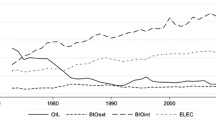Abstract
The purpose of this paper is to analyse altering energy demand patterns and energy factor substitution possibilities over time in the pulp and paper industry in order to increase our understanding of suitable policy options for increasing energy efficiency. The investigation employs a flexible translog cost function and an unbalanced panel data set covering 32 pulp and paper mills over the time period 1974–2005 in Sweden. Specifically, we test whether energy factor demand patterns in the industry for the period 1974–1990 differ from those during the latter period, 1991–2005. The empirical results reveal that even though the Swedish pulp and paper industry is relatively insensitive to changes in energy factor input prices in the short run, we find evidence of significant changes over time. According to the results, the own-price sensitivity of fuel has increased since the 1970s and the 1980s, thus indicating that fuel demand has become more sensitive to short-run changes in relative prices. The estimated cross-price elasticities between electricity and fuel also support the hypothesis of increased substitutability over time. However, the null hypothesis of an equal own-price elasticity of electricity demand across the two time periods cannot be rejected.
Similar content being viewed by others
References
Baltagi, B. H. (1995). Econometric analysis of panel data. New York: Wiley.
Berndt, E. R., & Wood, D. (1975). Technology, prices and the derived demand for energy. Review of Economics and Statistics, 57(3), 259–268.
Berndt, E. R., Friedlander, A., Chiang, J., & Vellturo, C. (1993). Cost effects of mergers and deregulation in the U.S. rail industry. The Journal of Productivity Analysis, 4, 127–144.
Brännlund, R., & Lundgren, T. (2007). Swedish Industry and Kyoto—an assessment of the effects of the European CO2 emission trading system. Energy Policy, 35, 4749–4762.
Chambers, R. G. (1988). Applied production analysis—a dual approach. New York: Cambridge University Press.
Christensen, L. R., Jorgenson, D. W., & Lau, L. J. (1971). Conjugate duality and the transcendental logarithmic function. Econometrica, 39, 255–256.
Christensen, L. R., Jorgenson, D. W., & Lau, L. J. (1973). Transcendental logarithmic production frontiers. Review of Economics and Statistics, 55, 28–45.
Collins, L. (1994). Environmental performance and technological innovation: the pulp and paper industry as a case in point. Technology in Society, 16, 427–446.
Ericsson, K., Nilsson, L., & Nilsson, M. (2011). New energy strategies in the Swedish pulp and paper industry—the role of national and EU climate and energy policies. Energy Policy, 39(3), 1439–1449.
Friedlander, A., Berndt, E. R., Chiang, J., Showalter, M., & Vellturo, C. (1993). Rail costs and capital adjustments in a quasi-regulated environment. Journal of Transport Economics and Policy, 27, 131–152.
Greene, W. (1993). Econometric analysis. New York: Macmillan.
Griffin, J. M. (1977). Inter-fuel substitution possibilities: a translog application to inter-country data. International Economic Review, 18, 755–770.
Heady, E., & Dillon, J. (1961). Agricultural production functions. Ames: Iowa State University Press.
Henriksson, E., & Söderholm, P. (2009). The cost-effectiveness of voluntary energy efficiency programs. Energy for Sustainable Development, 13, 235–243.
Högselius, P., & Kaijser, A. (2007). När folkhemselen blev internationell. Elavregleringen i historiskt perspektiv. Stockholm: SNS förlag.
Lee, L.-F., & Pitt, M. (1986). Microeconometric demand systems with binding non-negativity constrains: the dual approach. Econometrica, 5, 1237–1242.
Lee, L.-F., & Pitt, M. (1987). Microeconometric models or rationing imperfect markets, and non-negativity constraints. Journal of Econometrics, 36, 89–110.
Lundgren, T., & Sjöström, M. (1999). Dynamic factor demand model for the Swedish pulp industry—an Euler equation approach. Journal of Forest Economics, 5(1), 45–67.
Lundmark, R. (2003). Investment behaviour in the European pulp and paper industry. Scandinavian Journal of Forest Research, 18, 184–192.
Lundmark, R., & Söderholm, P. (2003). Structural changes in Swedish wastepaper demand: a variable cost function approach. Journal of Forest Economics, 9, 41–63.
Lundmark, R., & Söderholm, P. (2004). Estimating and decomposing the rate of technical change in the Swedish pulp and paper industry: a general index approach. International Journal of Production Economics, 91, 17–35.
Samakovlis, E. (2003). The relationship between waste paper and other inputs in the Swedish paper industry. Environmental and Resource Economics, 25, 191–212.
Söderholm, P., & Lundmark, R. (2009). The development of forest-based biorefineries: implications for market behavior and policy. Forest Products Journal, 59(1–2), 6–16.
Stenqvist, C., E. Henriksson, L. J. Nilsson, P. Söderholm, and L. Wårell (2009). Voluntary energy efficiency programs: an interim evaluation of PFE in Sweden. In Conference Proceedings of the 10th IAEE European Conference, Vienna, Austria, 7–10 September, 2009.
Swedish Energy Agency (2005). Skattebefrielse på el—för effektiv energianvändning i industrin, ET 2005:03, Eskilstuna, Sweden.
Swedish Energy Agency (2008). Energy in Sweden 2008. ER 2008:16, Eskilstuna, Sweden.
Swedish Energy Agency (2009). Resultat från PFEs första programperiod, Eskilstuna, Sweden.
Uzawa, H. (1962). Production functions with constant elasticities of substitution. Review of Economic Studies, 29(4), 803–812.
Varian, H. R. (1992). Microeconomic analysis (3rd ed.). New York: W. W. Norton & Company, Inc.
Zavatta, R. (1993). The pulp and paper industry. In H. W. de Jong (Ed.), The structure of European industry. Amsterdam: Kluwer Academic Publisher.
Acknowledgments
Financial support from the Swedish Energy Agency is gratefully acknowledged as are helpful comments from Patrik Söderholm. We also thank Bio4Energy, a strategic research environment appointed by the Swedish government, for supporting this work.
Author information
Authors and Affiliations
Corresponding author
Rights and permissions
About this article
Cite this article
Henriksson, E., Lundmark, R. Structural changes in industrial electricity use: the case of the pulp and paper industry in Sweden. Energy Efficiency 6, 305–314 (2013). https://doi.org/10.1007/s12053-012-9176-4
Received:
Accepted:
Published:
Issue Date:
DOI: https://doi.org/10.1007/s12053-012-9176-4




